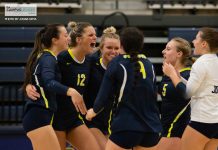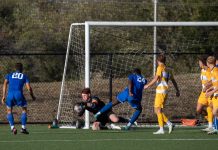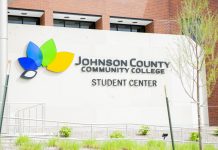Connor Heaton
Staff reporter
With the aid of the Student Sustainability Committee and several student volunteers, Krystal Anton, Waste Minimization Coordinator, launches a research study into the bird strikes across campus.
Anton said the study is set to begin in April and runs until the end of 2018. She wants to make sure everything is ready before peak migration season in May, the greatest opportunity to collect data.
The study involves student volunteers venturing out on designated routes or “bird walks” to locate and document the bird strikes they find along the way.
Caitlyn Eberle and Andrew Kimeu, students, are two of Anton’s interns who helped set up the study.
“My personal involvement has been to help create and walk the routes, setting up the procedure and labeling/mapping out windows on campus,” Eberle said.
Kimeu, who assisted in planning the walks, agrees this is a serious problem.
“Aside from day-to-day findings, each time going out, the issue becomes more apparent,” Kimeu said. “This is an a problem and the data will support the cause.”
Anton said typically, that birds can be found in specific locations, outside large windows or glass bridges are common, but the bird walk route takes volunteers to unusual places as well such as rooftops and the window well that lights the down under.
Each walk lasts between 30 and 45 minutes, and takes place before 8 a.m.. Anton said she is still working out the number of volunteers, but she estimates she will need six people for each bird walk. Anton has been working closely with her interns since before the official study.
If a volunteer spots a struck bird, they take a detailed photo and report its precise location. The volunteer would then carefully bag the bird which will be sent to Kansas University to be composted in their waste management facility.
The study collaborates mainly with biologists at Stantec, an engineering firm that works with wind turbines. Anton said they are studying bird and bat deaths, and the college’s research is a way to corroborate findings. The photos and locations they record are uploaded to a master database.
“Other biologists will see [our] posting and they will come on and identify your bird and then other people confirm that identification or dispute it,” Anton said.
Anton said she wants to recruit the aid of student “citizen scientists” as well.
Starting in April, signs will be posted throughout the college detailing specific process of photographing and documenting the bird’s locations. Students will then be able to tag their post with #JCCCbirds and send it into the database.
The database is called the JCCC Bird Collision Study, and it is where volunteers post images and locations of the birds they find. The information is displayed on an interactive map of the college campus. There, one can hover over each incident and discover the species of bird along with with the specific time and location of the finding.
Since January 30, there have been 21 observations of nine species.
“The more we know, the more we understand the issue the goal is to figure out the worst locations are and what the problems are, because I don’t think they’re all the same,” Anton said.
The main causes for these fowl fatalities, Anton states, are lighting, reflection and transparency.
“The bridge from the GEB looks like the sky from the distance and at night they get disoriented by the lights,” Anton said.
Anton said the bridges and the OCB dock are particularly nasty. Before setting up the walks, she said she found a place with 12 dead birds.
“One was brand new like within days one was probably a few months old and the other ones were just piles of bones,” Anton said.
Some, however, don’t die on impact. In the case a volunteer finds an injured bird, they take it to Operation Wildlife, which provides rehabilitation services for wounded animals.
“If we were to find a bird and it had not been killed, we would call one of the rescuers up and we would will have boxes set up to put the injured animals into,” Anton said.
Anton said she used to work with Operation Wildlife before her tenure at the college, but her fascination with the issue began only a few years ago.
She and a few of her interns began crowdsourcing local bird deaths on a small scale through most of 2017, but Anton wanted to go further.
“I talked to the Student Sustainability Committee about it last year to see if they would be interested in funding an actual full-blown study and they agreed,” Anton said.
Anton said the SSC gave her up to $10,000 to fund her study, including equipment, plastic bags and scientific consultants.
The issue goes far beyond the college. Anton said she hears from students that they have the same problem at home, but there ways to help.
“You can cut out those black birds to put on the window but the problem is that all the birds see is a reflection and most people put that stuff on the inside of the window,” she said. “If you don’t break that reflection it really is ineffective.”
Anton advises students put anything up, from dots to wind chimes, anything to break the reflection.
She said after the results of the study come out, it could spark action. Since reflection is a considerable issue, Anton said there could be plans to reduce the brightness of the campus’ lights.
Anton said, “That could be very expensive, but this campus has a strong sustainability initiative and we have the ability to do something about all of this.”
For more information regarding the bird collision study, contact Krystal Anton at [email protected] or 913-469-8500 x4929






















